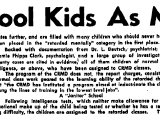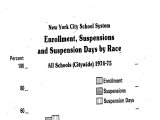You are here:
Tests, Labels, and Discipline
Many policies outside of schools – such as in housing – produce segregation between schools. But segregation happens through practices inside schools as well. Black and Latinx students and Disabled students and students labeled as disabled are likely to experience different courses, climates, classrooms, and discipline measures than their white or non-disabled peers. This is not an accident. It is often the result of identifiable policy choices within schools.
Read More
Segregationist practices, both past and present, reflect racist and ableist ideas. In many cases, school practices show how racism and ableism are and have been connected and interdependent in education. Consider, for example, how racist ideas about Black students can then lead to diminished educational opportunity for those Black students. These diminished opportunities can then be disabling – that is, they can make students more likely to have disabilities or receive disability labels – and they can mean that Disabled students of color don’t receive the supports they deserve. Together, these ideas and practices reinforce each other and create a cycle that limits students’ educational opportunities.
These documents include evidence of many practices inside schools - from intelligence testing to disciplinary suspensions to exclusion from school entirely through disability labels and placement in so-called “600” schools - that produce inequality and segregation by race and ability. These practices are often related to admissions policies - how the school system decides who goes where - that are the focus of the Mark Twain Today documents as well.
These documents ask us to evaluate the idea that Mark Twain could be desegregated by making the school a “gifted and talented” school. And they ask us to consider whether and how these practices of segregation continue in New York City schools today.






